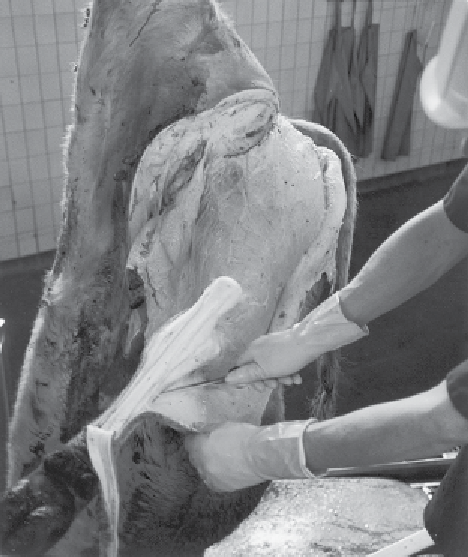Agriculture Reference
In-Depth Information
Figure 8.3
The initial incision, which will be extended using the spear cut technique. Effective out-rolling of hide is shown at right (by
courtesy of R. H. S. Moore BA, MVE, MRCVS).
the following text. These are, however, only suggestions
and not all will be appropriate under every circumstance.
The skill of the professionally trained veterinarian is to
understand the general principles so that they can assess
the efficacy of the slaughterhouse operator's procedures in
achieving the desired outcome and when required can
advise the operator how to adapt procedures to address a
particular practical situation or problem encountered.
knife. All incisions from this initial one should then be
made using a
spear cut technique
, where the blade of the
knife is reversed so that its back is against the carcase and
the cut is made from the inside of the skin towards the
outside, or to put it another way, from clean towards dirty.
This results in reduced contamination (Fig. 8.3).
To illustrate the point, consider a common procedure
for freeing the hide from the rear quarters during on-line
dressing of cattle. An initial short incision is made along
the ventral midline between the hindlegs of the suspended
animal. The knife used is washed and placed in the steri-
liser, hands, arms and apron washed and a clean sterilised
knife is collected from the steriliser. The initial incision is
extended downwards towards the umbilicus, and upwards
along the free hind limb towards the hock, using the spear
technique. Skinning then proceeds from these incisions.
During skinning, the carcase frequently becomes con-
taminated from in-rolling at the edges of the hide. Small
alterations to the positioning of the skinning incisions is
often sufficient to alter the way in which the hide hangs
and so eradicate the problem. The use of pairs of croco-
dile clips joined by an elastic cord has been found to be a
useful tool in the prevention of in-rolling, especially
when used at the hide-puller.
A particular problem with hide-pullers, especially
those which pull upwards, is dirt flicking from the hide
on to the exposed carcase as the hide finally detaches
Cattle
Dry, clean cattle, having been stunned, are allowed to slide
or tumble from the stunning box. The use of raised slats or
metal grid in this area - the dry landing area - is essential
in order to keep the animals as clean and dry as possible.
Small
et al.
(2002) concluded that the stunning box area
was a potential source of cross-contamination of zoonotic
bacteria as animals with clean hides fall out onto the same
area of floor following stunning as contaminated ones.
The cattle are then hoisted by the leading hindleg on to the
line and bled before the removal of the hide commences.
An incision through the skin, the knife moving as it
must through the dirty exterior towards and into the
clean interior, is always fraught with the hygienic risk of
pushing dirt or hair on to the carcase. These initial cuts
must, therefore, be carried out with great care and kept as
short as possible. Once through the skin, the knife must
be washed and sterilised, and/or exchanged for a clean


